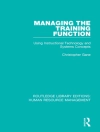What explains the international mobility of workers from developing to advanced societies? Why do workers move from one region to another? Theoretically, the supply of workers in a given region and the demand for them in another account for the international mobility of laborers. Job seekers from less developed regions migrate to more advanced countries where technological and productive transformations have produced a shortage of laborers. Using the Dominican labor force in New York as a case study, Ramona Hernández challenges this presumption of a straightforward relationship between supply and demand in the job markets of the receiving society. She contends that the traditional correlation between migration and economic progress does not always hold true. Once transplanted in New York City, Hernández shows, Dominicans have faced economic hardship as the result of high levels of unemployment and underemployment and the reality of a changing labor market that increasingly requires workers with skills and training they do not have. Rather than responding to a demand in the labor market, emigration from the Dominican Republic was the result of a de facto government policy encouraging poor and jobless people to leave—a policy in which the United States was an accomplice because the policy suited its economic and political interests in the region.
Table des matières
List of Tables
Acknowledgments
Introduction
Part 1. Leaving the Land of the Few
1. The Great Exodus: Its Roots
2. Economic Growth and Surplus Population
Part 2. Settling in the Land of Dreams
3. The Perception of a Migratory Movement
4. Dominicans in the Labor Market
5. On the International Mobility of Labor
6. Conclusion: Assessing the Present and Auguring the Future
Appendix: Figures
Notes
Works Cited
Index
A propos de l’auteur
Ramona Hernández is the director of the CUNY Dominican Studies Institute. She is the author of
The Dominican Americans.












